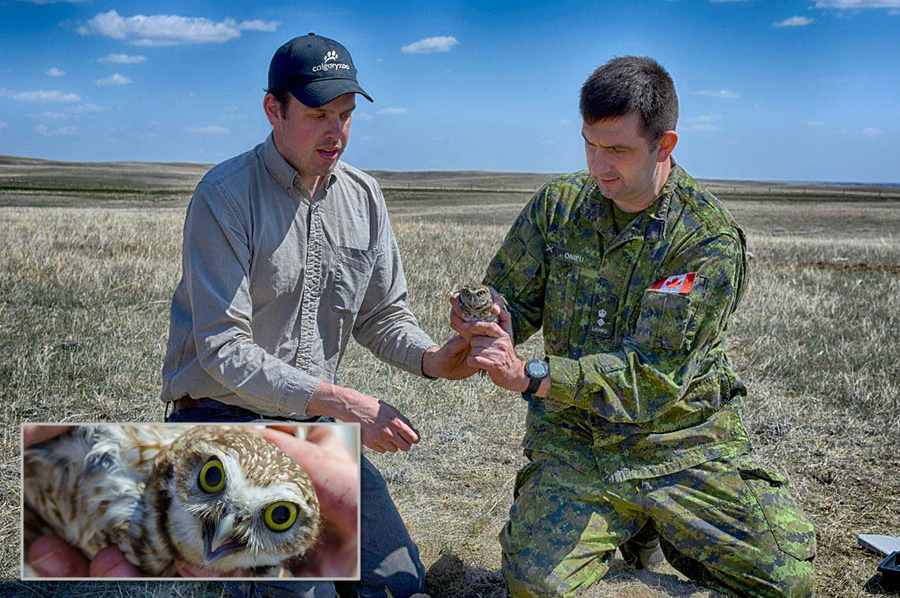Soldiers and scientists join forces to help recover an endangered species
By Lookout on Jul 12, 2018 with Comments 0

Graham Dixon-MacCallum (left) and Lieutenant-Colonel Mike Onieu, Base Commander (right), release the first burrowing owl into the CFB Suffield National Wildlife Area on May 3 as part of a new head-starting project to help this endangered species. Photo by Warrant Officer Derrick Steeves
Jocelyn Antonovitch, CFB Suffield Public Affairs ~
The tiny Burrowing Owl, weighing a little more than a baseball and standing as high as a pigeon, is a rare sight at Canadian Forces Base (CFB) Suffield.
“People who are not from the Great Plains region of North America do not know they exist and find it amazing that owls nest underground,” said Graham Dixon-MacCallum, Conservation Research Associate, Calgary Zoo.
Despite their name, Burrowing Owls do not make a burrow on their own, but instead occupy those that have been abandoned by burrowing mammals, and make modifications where needed.
CFB Suffield joined forces with the Calgary Zoo, and Environment and Climate Change Canada (ECCC) on a head-starting project to improve the survival rate of the endangered Burrowing Owl.
The head-starting project takes a few owlets, raises them in captivity over the winter in the Calgary Zoo’s offsite Devonian Wildlife Conservation Centre, and allows them to grow large enough to be released as breeding adults.
ECCC and Calgary Zoo scientists want to test the theory that increasing the owls’ first-year survival may in turn reduce the rate of population decline in Canada.
“They are not on their last legs, but their population is steadily declining. They are becoming more and more rare,” said Troy Wellicome, Senior Species at Risk Biologist, Canadian Wildlife Service, ECCC. “If we did nothing for 20 years, it is debatable if they would still be around in Canada.”
The Calgary Zoo and ECCC returned four pairs of owls to the CFB Suffield National Wildlife Area this spring, where they had been captured as owlets the previous year.
“The National Wildlife Area on CFB Suffield just presents an excellent opportunity. We have trapped owls in the National Wildlife Area in previous years, so now we can release some back there,” said Dixon-MacCallum.
As the only protected area managed by the Department of National Defence (DND), the CFB Suffield National Wildlife Area was established in 2003 to conserve prairie habitat and its many wildlife species, including more than 1,100 plants and animals, about 20 of which are species at risk.
The CFB Suffield National Wildlife Area, at 458 square kilometres, is one of the largest areas of undisturbed prairie left in Canada. This is an ideal location for this project, because of its size and that it is closed to the public. It also houses a small but healthy number of wild nesting pairs each year.
Because military training happens nearby, the chosen sites were cleared of any potential surface-hazards prior to this spring’s release. Support from CFB Suffield didn’t stop at clearing the area; Canadian Armed Forces members donned their work gloves and gave truly hands-on assistance digging and placing artificial burrows assembled from plastic nest boxes with tunnels.
For Dixon-MacCallum, one of the most unique aspects of this project was the opportunity to work closely with military personnel.
“Soldiers are a very organized group of people. All in all, just great people to work with. They are really kind, genuine and happy to be working on this project. It was a real pleasure,” he said about the experience.
Warrant Officer Sheldon Porter, who manages the Range Maintenance Department at CFB Suffield, was one of the military personnel who cleared the area and dug the artificial burrows.
“All the boys enjoyed it, it was fun. It was interesting to give something back,” said WO Porter.
“From the DND perspective, having a National Wildlife Area allows us to do some recovery activities for species at risk, so this was a great partnership overall,” said Danny Laganière, Base Environmental Officer CFB Suffield.
As part of the head-starting process, each pair of owls were released into their own burrow and further protected with a temporary above ground enclosure made from soft netting.
The enclosure is only removed after the owls have laid eggs in hopes that the owls will remain in the area with their offspring.
“They have pretty high investments once they have mated and laid eggs. They will want to stick around that burrow until the eggs have hatched,” said Dixon-MacCallum.
ECCC and the Calgary Zoo will continue to monitor the progress of the newly-released owls and their young until the fall when they migrate to Texas and Mexico for the winter.
Later this summer, ECCC and Calgary Zoo staff will trap owlets born this year to be raised at the Devonian Wildlife Conservation Centre and released next spring.
With the help of CFB Suffield, the Calgary Zoo and ECCC plan to continue trialing the head-start program into the future, with the hopes that one day Burrowing Owls will recover and become a self-sustaining population.
Filed Under: Top Stories
About the Author:





